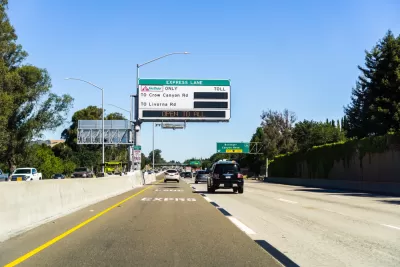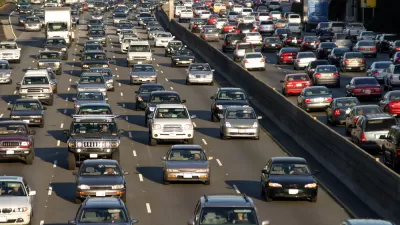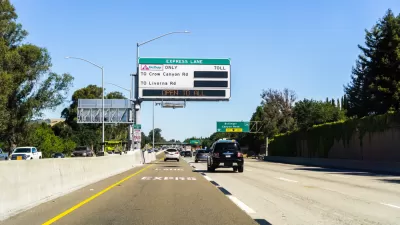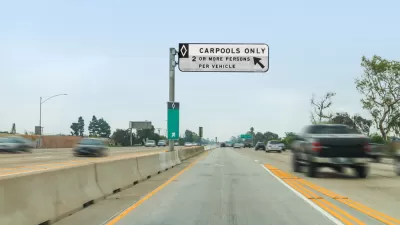The day after California voters soundly rejected a repeal of a one-year old 12-cents gas tax increase and new annual vehicle registration fees. the Riverside County Transportation Commission launched a study to extend toll lanes on Interstate 15.

On Nov. 7, the Riverside County Transportation Commission issued a Request for Qualifications to consulting firms to begin preliminary engineering and environmental studies for a proposed 14.5-mile extension of two toll lanes on Interstate 15 from Corona to Lake Elsinore. The California Transportation Commission had already allocated $50 million for the study in March but had placed one contingency on spending them: the taxes and fees in the Road Repair and Accountability Act of 2017 needed to remain.
"Now that Prop. 6 has failed [on Nov. 6] — 'no matter how you felt about the gas tax' — Lake Elsinore Councilman Bob Magee said the agency can cobble together enough money to build the $544 million extension," reports David Downey for The Press-Enterprise.
The [Riverside Transportation Commission] made that a goal in 2006, when it adopted a long-term vision, said Magee, a long-time commissioner. But little has been done to make it reality.
The study of the I-15 toll lane extensions will occur during construction of two 14.6-mile toll lanes from I-15 from the Temescal Valley, south of Corona, north to Jurupa Valley which began earlier this year, described earlier by Imran Ghori of The Press-Enterprise (and posted here), which are expected to open by mid-2020. Downey updates other highway projects in the county as well.
Paying for road projects – the "message is clear"
In a related "Tolling Points" column for the International Bridge, Tunnel & Turnpike Association (IBTTA), Bill Cramer writes that the rejection of Prop. 6 "was one of the highest-profile developments for transportation, along with the election or re-election of two northeastern governors with an affinity for truck tolling, when the United States held midterm elections November 6." User fees in the form of tolls and gas taxes supply needed funding.
The message is clear: Nothing is free. Roads, bridges, tunnels, maintenance and efforts to reduce congestion all cost money and will be paid for with either taxes, tolls or a combination.
“This is the way infrastructure investment is supposed to work,” said IBTTA Executive Director and CEO Patrick Jones... Citizens get to decide when and whether to invest in those improvements. When they are ready to proceed, transportation agencies are ready to roll. And tolling is an important part of the solution.”
Related: Is the Era of the 'Free' Freeway Coming to an End? August 18, 2017: Riverside County receives TIFIA funding for I-15 Express Lanes.
State legislators re-elected for supporting gas tax hikes
Cramer also cites an analysis from American Road & Transportation Builders Association’s Transportation Investment Advocacy Center.
"Voters in 12 states overwhelmingly re-elected 93 percent of 530 state lawmakers who supported a gas tax increase between 2015 and 2018 and ran for re-election in 2018," reports
"The Republican-led recall of Newman passed with nearly two-thirds support Tuesday," reported Melody Gutierrez on June 6 for the San Francisco Chronicle.
Recall leaders said it showed strong voter sentiment in favor of an initiative likely to be on the November ballot that would repeal the tax hike.
“Make no mistake about it: State Sen.Josh Newman’s political career is over because he supported the car and gas tax hikes,” said recall leader Carl DeMaio.
The strategy may have worked in June, but not in November as six Congressional Republicans were replaced by Democrats, and Democrats regained super-majority control of the state legislature.
"Before this election, the 53-member California congressional delegation included 39 Democrats and 14 Republicans," reports Adam Nagourney for The New York Times on Nov. 17.
...[A]fter this year’s midterms it will be 45 Democrats and eight Republicans.
Democrats set out to capture seven Republican-held seats where Hillary Clinton defeated President Trump in 2016, including four in Orange County. They won six of them. [The one they missed was Rep. David Valadao (Hanford) in the San Joaquin Valley].
FULL STORY: After voters keep gas tax, plans for 15 Freeway toll lanes from Corona to Lake Elsinore move ahead

Trump Administration Could Effectively End Housing Voucher Program
Federal officials are eyeing major cuts to the Section 8 program that helps millions of low-income households pay rent.

Planetizen Federal Action Tracker
A weekly monitor of how Trump’s orders and actions are impacting planners and planning in America.

Ken Jennings Launches Transit Web Series
The Jeopardy champ wants you to ride public transit.

California Invests Additional $5M in Electric School Buses
The state wants to electrify all of its school bus fleets by 2035.

Austin Launches $2M Homelessness Prevention Fund
A new grant program from the city’s Homeless Strategy Office will fund rental assistance and supportive services.

Alabama School Forestry Initiative Brings Trees to Schoolyards
Trees can improve physical and mental health for students and commnity members.
Urban Design for Planners 1: Software Tools
This six-course series explores essential urban design concepts using open source software and equips planners with the tools they need to participate fully in the urban design process.
Planning for Universal Design
Learn the tools for implementing Universal Design in planning regulations.
Ada County Highway District
Clanton & Associates, Inc.
Jessamine County Fiscal Court
Institute for Housing and Urban Development Studies (IHS)
City of Grandview
Harvard GSD Executive Education
Toledo-Lucas County Plan Commissions
Salt Lake City
NYU Wagner Graduate School of Public Service





























